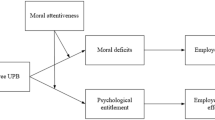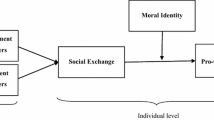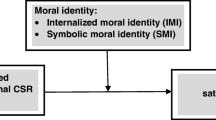Abstract
Over two (i.e., a 2 × 2 experiment and a multi-source field study) studies, we propose and demonstrate how employees increase their emotional (i.e., affective commitment) and behavioral (i.e., citizenship behavior) investments in the workplace as a valuable outcome of the trickle-down effect of organizational inclusiveness. We also explain how supervisory moral identity impacts the trickle-down effect. Notably, the research integrates social cognitive theory with the diversity and inclusion literature to enhance our understanding as to how organizations can create a welcoming environment for all organizational members. Theoretical and practical implications are discussed.
Similar content being viewed by others
References
Acquavita, S. P., Pittman, J., Gibbons, M., & Castellanos-Brown, K. (2009). Personal and organizational diversity factors’ impact on social workers’ job satisfaction: results from a national internet-based survey. Administration in Social Work, 33, 151–166.
Aguinis, H., & Bradley, K. J. (2014). Best practice recommendations for designing and implementing experimental vignette methodology studies. Organizational Research Methods, 17, 351–371.
Aiman-Smith, L., Scullen, S. E., & Barr, S. H. (2002). Conducting studies of decision making in organizational contexts: a tutorial for policy-capturing and other regression-based techniques. Organizational Research Methods, 5, 388–414.
Allen, N. J., & Meyer, J. P. (1990). The measurement and antecedents of affective, continuance, and normative commitment to the organization. Journal of Occupational Psychology, 63, 1–18.
Ambrose, M. L., Schminke, M., & Mayer, D. M. (2013). Trickle-down effects of supervisor perceptions of interactional justice: A moderated mediation approach. Journal of Applied Psychology, 98(4), 678.
Aquino, K., Freeman, D., Reed II, A., Lim, V. K. G., & Felps, W. (2009). Testing a social-cognitive model of moral behavior: the interactive influence of situations and moral identity centrality. Journal of Personality and Social Psychology, 97, 123–141.
Aquino, K., & Reed, A. (2002). The self-importance of moral identity. Journal of Personality and Social Psychology, 83, 1423–1440.
Arnold, H. J., & Feldman, D. C. (1981). Social desirability response bias in self-report choice situations. Academy of Management Journal, 24, 377–385.
Avery, D. R., McKay, P. F., Wilson, D. C., & Volpone, S. (2008). Attenuating the effect of seniority on intent to remain: the role of perceived inclusiveness. Paper presented at the meeting of the Academy of Management, Anaheim, CA.
Bacharach, S., Bamberger, P., & Vashdi, D. (2005). Diversity and homophily at work: supportive relations among white and African-American peers. Academy of Management Journal, 48, 619–644.
Bandura, A. (1977). Social learning theory. Englewood Cliffs: Prentice- Hall.
Bandura, A. (1986). Social foundations of thought & action. Englewood Cliffs: Prentice-Hall.
Becker, T. E. (2005). Potential problems in the statistical control of variables in organizational research: a qualitative analysis with recommendations. Organizational Research Methods, 8, 274–289.
Becker, T. E., Atinc, G., Breaugh, J. A., Carlson, K. D., Edwards, J. R., & Spector, P. E. (2016). Statistical control in correlational studies: 10 essential recommendations for organizational researchers. Journal of Organizational Behavior, 37(2), 157–167.
Bilimoria, D., Joy, S., & Liang, X. (2008). Breaking barriers and creating inclusiveness: lessons of organizational transformation to advance women faculty in academic science and engineering. Human Resource Management, 47, 423–441.
Blasi, A. (1984). Moral identity: Its role in moral functioning. In W. Kurtines & J. Gewirtz (Eds.), Morality, moral behavior and moral development (pp. 128–139). New York: Wiley.
Blasi, A. (1993). The development of identity: some implications for moral functioning. In G. G. Naom & T. E. Wren (Eds.), The moral self (pp. 99–122). Cambridge, MA: MIT Press.
Boegershausen, J., Aquino, K., & Reed II, A. (2015). Moral identity. Current Opinion in Psychology, 6, 162–166.
Bretz Jr., R. D., & Judge, T. A. (1994). The role of human resource systems in job applicant decision processes. Journal of Management, 20, 531–551.
Cable, D. M., & Judge, T. A. (1994). Pay preferences and job search decisions: a person-organization fit perspective. Personnel Psychology, 47, 317–348.
Colquitt, J. A., Conlon, D. E., Wesson, M. J., Porter, C. O., & Ng, K. Y. (2001). Justice at the millennium: a meta-analytic review of 25 years of organizational justice research. Journal of Applied Psychology, 86, 425–445.
Cho, S., & Mor Barak, M. E. (2008). Understanding of diversity and inclusion in a perceived homogeneous culture: a study of organizational commitment and job performance among Korean employees. Administration in Social Work, 32, 100–126.
Cropanzano, R., & Mitchell, M. S. (2005). Social exchange theory: an interdisciplinary review. Journal of Management, 31, 874–900.
Dean, J. W., Brandes, P., & Dharwadkar, R. (1998). Organizational cynicism. Academy of Management Review, 23, 341–352.
Douglas, C., Ferris, G. R., Buckley, M. R., & Gundlach, M. J. (2003). Organizational and social influences on leader–member exchange processes: implications for the management of diversity. In G. Graen (Ed.), Dealing with diversity (pp. 59–90). Greenwich: Information Age.
Downey, S. N., Werff, L., Thomas, K. M., & Plaut, V. C. (2015). The role of diversity practices and inclusion in promoting trust and employee engagement. Journal of Applied Social Psychology, 45, 35–44.
Doyle, R. P., Chase, J. S., Gadde, S., & Vahdat, A. M. (2002). The trickle-down effect: Web caching and server request distribution. Computer Communications, 25(4), 345–356.
Durbin, J., & Watson, G. S. (1971). Testing for serial correlation in least squares regression. III. Biometrika, 58(1), 1–19.
Edwards, J. R., & Lambert, L. S. (2007). Methods for integrating moderation and mediation: a general analytical framework using moderated path analysis. Psychological Methods, 12, 1–22.
Eisenberger, R., Fasolo, P., & Davis-LaMastro, V. (1990). Perceived organizational support and employee diligence, commitment, and innovation. Journal of Applied Psychology, 75, 51–59.
Eisenberger, R., Huntington, R., Hutchison, S., & Sowa, D. (1986). Perceived organizational support. Journal of Applied Psychology, 71, 500–507.
Elvira, M. M., & Cohen, L. E. (2001). Location matters: a cross-level analysis of the effects of organizational sex composition on turnover. Academy of Management Journal, 44, 591–605.
Ely, R. J., & Thomas, D. A. (1996). Making differences matter: A new paradigm for managing diversity. Harvard Business Review, 74(5), 79–90.
Feldman, D. C., & Arnold, H. J. (1978). Position choice: comparing the importance of organizational and job factors. Journal of Applied Psychology, 63, 706–710.
Grojean, M. W., Resick, C. J., Dickson, M. W., & Smith, D. B. (2004). Leaders, values, and organizational climate: Examining leadership strategies for establishing an organizational climate regarding ethics. Journal of Business Ethics, 55(3), 223–241.
Gujarati, D. N. (2003). Basic econometrics (4th ed.). West Point: McGraw Hill United States Military Academy.
Harrison, D. A., Price, K. H., & Bell, M. P. (1998). Beyond relational demography: time and the effects of surface- and deep-level diversity on work group cohesion. Academy of Management Journal, 41, 96–107.
Hayes, A. F. (2013). PROCESS: a versatile computational tool for observed variable mediation, moderation, and conditional process modeling [White paper]. Retrieved from http://www.afhayes.com/.
Highhouse, S. (2008). Stubborn reliance on intuition and subjectivity in employee selection. Industrial and Organizational Psychology, 1, 333–342.
Hox, J. (2002). Multilevel analyses: techniques and applications. Mahwah: Erlbaum.
Jehn, K. A., Northcraft, G. B., & Neale, M. A. (1999). Why differences make a difference: a field study of diversity, conflict, and performance in workgroups. Administrative Science Quarterly, 44, 741–763.
Jöreskog, K. G., & Sörbom, D. (2006). Structural equation modeling with the SIMPLIS command language. Chicago: Scientific Software.
Karren, R. J., & Barringer, M. W. (2002). A review and analysis of the policy-capturing methodology in organizational research: guidelines for research and practice. Organizational Research Methods, 5, 337–361.
Katz, D. (1964). The motivational basis of organizational behavior. Behavioral Science, 9, 131–146.
Konovsky, M. A., & Pugh, S. D. (1994). Citizenship behavior and social exchange. Academy of Management Journal, 37, 656–669.
Lambert, S. J. (2000). Added benefits: the link between work-life benefits and organizational citizenship behavior. Academy of Management Journal, 43, 801–815.
Letwin, C., Wo, D., Folger, R., Rice, D., Taylor, R., Richard, B., & Taylor, S. (2016). The “right” and the “good” in ethical leadership: implications for supervisors’ performance and promotability evaluations. Journal of Business Ethics, 137(4), 743–755.
Liden, R. C., Bauer, T. N., & Erdogan, B. (2004). The role of leader-member exchange in the dynamic relationship between employer and employee: Implications for employee socialization, leaders, and organizations. The employment relationship: Examining psychological and contextual perspectives, 226–250
Lirio, P., Lee, M. D., Williams, M. L., Haugen, L. K., & Kossek, E. E. (2008). The inclusion challenge with reduced load professionals: the role of the manager. Human Resource Management, 47, 443–461.
Lykken, D. (1968). Statistical significance in psychological research. Psychological Bulletin, 70, 151–159.
McKay, P. F., & Avery, D. R. (2006). What has race got to do with it? Unraveling the role of racioethnicity in job seekers'reactions to site visits. Personnel Psychology, 59(2), 395–429.
McKay, P. F., Avery, D. R., Tonidandel, S., Morris, M. A., Hernandez, M., & Hebl, M. R. (2007). Racial differences in employee retention: are diversity climate perceptions the key? Personnel Psychology, 60, 35–62.
Markus, H., & Kunda, Z. (1986). Stability and malleability of the self-concept. Journal of Personality and Social Psychology, 51, 858.
Mawritz, M. B., Mayer, D. M., Hoobler, J. M., Wayne, S. J., & Marinova, S. V. (2012). A trickle-down model of abusive supervision. Personnel Psychology, 65, 325–357.
Mayer, D. M., Aquino, K., Greenbaum, R. L., & Kuenzi, M. (2012). Who displays ethical leadership and why does it matter? An examination of antecedents and consequences of ethical leadership. Academy of Management Journal, 55, 151–171.
Mayer, D., Kuenzi, M., Greenbaum, R., Bardes, M., & Salvador, R. (2009). How low does ethical leadership flow? Examining the effects of supervisory and top management ethical leadership. Organizational Behavior and Human Decision Processes, 108, 1–13.
Meyer, J. P., Allen, N. J., & Smith, C. A. (1993). Commitment to organizations and occupations: extension and test of a three-component conceptualization. Journal of Applied Psychology, 78, 538–551.
Miller, F. A. (1998). Strategic culture change: the door to achieving high performance and inclusion. Public Personnel Management, 27, 151–160.
Nembhard, I. M., & Edmondson, A. C. (2006). Making it safe: the effects of leader inclusiveness and professional status on psychological safety and improvement efforts in health care teams. Journal of Organizational Behavior, 27, 941–966.
Nicklin, J. M., Greenbaum, R., McNall, L. A., Folger, R., & Williams, K. J. (2011). The importance of contextual variables when judging fairness: an examination of counterfactual thoughts and fairness theory. Organizational Behavior and Human Decision Processes, 114, 127–141.
Nishii, L. H. (2013). The benefits of climate for inclusion for gender-diverse groups. Academy of Management Journal, 6, 1754–1774.
Nishii, L. H., & Mayer, D. M. (2009). Do inclusive leaders help to reduce turnover in diverse groups? The moderating role of leader-member exchange in the diversity to turnover relationship. Journal of Applied Psychology, 94, 1412–1426.
O’Reilly, C. A., Caldwell, D. F., & Barnett, W. P. (1989). Work group demography, social integration, and turnover. Administrative Science Quarterly, 34, 21–37.
Piccolo, R. F., Greenbaum, R., den Hartog, D. N., & Folger, R. (2010). The relationship between ethical leadership and core job characteristics. Journal of Organizational Behavior, 31, 259–278.
Podsakoff, P. M., MacKenzie, S. B., Lee, J.-Y., & Podsakoff, N. P. (2003). Common method variance in behavioral research: a critical review of the literature and recommended remedies. Journal of Applied Psychology, 88, 879–903.
Pugh, S. D., Dietz, J., Brief, A. P., & Wiley, J. W. (2008). Looking inside and out: the impact of employee and community demographic composition on organizational diversity climate. Journal of Applied Psychology, 93, 1422–1428.
Reed, I. I., & Aquino, K. F. (2003). Moral identity and the expanding circle of moral regard toward out-groups. Journal of Personality and Social Psychology, 84(6), 1270.
Rice, D. B. (2018). Millennials and institutional resentment. A new integrated process of marginalization, suppression, and retribution. In M. Gerhardt & J. Peluchette (Eds.), Millennials: Trends, characteristics, and perspectives. New York: Nova Science. Hauppauge.
Riordan, C. M. (2000). Relational demography within groups: past developments, contradictions, and new directions. Research in Personnel and Human Resources Management, 19, 131–173.
Roberson, Q. M. (2006). Disentangling the meanings of diversity and inclusion in organizations. Group and Organization Management, 31, 212–236.
Rousseau, D. M., & Anton, R. J. (1991). Fairness and implied contract obligations in job terminations: the role of contributions, promises, and performance. Journal of Organizational Behavior, 12, 287–299.
Ruiz, P., Ruiz, C., & Martínez, R. (2011). Improving the “leader–follower” relationship: Top manager or supervisor? The ethical leadership trickle-down effect on follower job response. Journal of Business Ethics, 99(4), 587–608.
Schneider, B. (1987). The people make the place. Personnel Psychology, 40, 437–453.
Shanock, L. R., & Eisenberger, R. (2006). When supervisors feel supported: relationships with subordinates' perceived supervisor support, perceived organizational support, and performance. Journal of Applied Psychology, 91, 689–695.
Shao, R., Aquino, K., & Freeman, D. (2008). Beyond moral reasoning: a review of moral identity research and its implications for business ethics. Business Ethics Quarterly, 18, 513–540.
Shore, L. M., Randel, A. E., Chung, B. G., Dean, M. A., Ehrhart, K. H., & Singh, G. (2010). Inclusion and diversity in work groups: a review and model for future research. Journal of Management, 37, 1262–1289.
Skarlicki, D. P., & Folger, R. (1997). Retaliation in the workplace: the roles of distributive, procedural, and interactional justice. Journal of Applied Psychology, 82, 434–443.
Stumpf, S. A., & London, M. (1981). Capturing rater policies in evaluating candidates for promotion. Academy of Management Journal, 24, 752–766.
Theodorakopoulos, N., & Budhwar, P. (2015). Guest editors’ introduction: diversity and inclusion in different work settings: emerging patterns, challenges, and research agenda. Human Resource Management, 54, 177–197.
Thomas, D. A., & Ely, R. J. (2001). A new paradigm for managing diversity. Harvard Business Review, 74(5), 79–94.
Umphress, E. E., Smith-Crowe, K., Brief, A. P., Dietz, J., & Watkins, M. B. (2007). When birds of a feather flock together and when they do not: status composition, social dominance orientation, and organizational attractiveness. Journal of Applied Psychology, 92, 396–409.
Wiersema, M., & Bird, A. (1993). Organizational demography in Japanese firms: group heterogeneity, individual dissimilarity, and top management team turnover. Academy of Management Journal, 36, 996–1025.
Williams, L. J., & Anderson, S. E. (1991). Job satisfaction and organizational commitment as predictors of organizational citizenship and in-role behaviors. Journal of Management, 17, 601–617.
Wrightsman, L. S. (1974). Assumptions about human nature: a social-psychological analysis. Monterey: Brooks/Cole.
Wu, I. H., Lyons, B., & Leong, F. T. (2015). How racial/ethnic bullying affects rejection sensitivity: the role of social dominance orientation. Cultural Diversity and Ethnic Minority Psychology, 21, 156–161.
York, K. M. (1989). Defining sexual harassment in workplaces: a policy-capturing approach. Academy of Management Journal, 32, 830–850.
Zhao, X., Sun, T., Cao, Q., Li, C., Duan, X., Fan, L., & Liu, Y. (2013). The impact of quality of work life on job embeddedness and affective commitment and their co-effect on turnover intention of nurses. Journal of Clinical Nursing, 22, 780–788.
Author information
Authors and Affiliations
Corresponding author
Additional information
Publisher’s note
Springer Nature remains neutral with regard to jurisdictional claims in published maps and institutional affiliations.
Electronic supplementary material
ESM 1
(PDF 582 kb)
Appendix
Appendix
Rights and permissions
About this article
Cite this article
Rice, D.B., Young, N.C.J. & Sheridan, S. Improving employee emotional and behavioral investments through the trickle-down effect of organizational inclusiveness and the role of moral supervisors. J Bus Psychol 36, 267–282 (2021). https://doi.org/10.1007/s10869-019-09675-2
Published:
Issue Date:
DOI: https://doi.org/10.1007/s10869-019-09675-2









